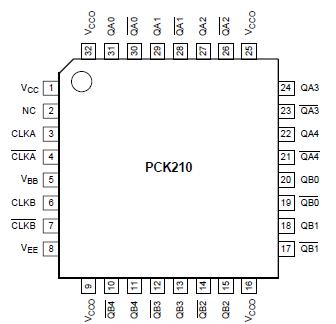Features: • 85 ps part-to-part skew typical
• 20 ps output-to-output skew typical
• Differential design
• VBB output
• Voltage and temperature compensated outputs
• Low voltage VEE range of -2.25 V to -3.8 V
• 75 k input pull-down resistors
• Form, fit, and function compatible with MC100EP210Pinout Specifications
Specifications
|
SYMBOL |
PARAMETER |
LIMITS |
UNIT |
|
MIN |
MAX |
|
VCC |
Supply voltage |
-0.3 |
+4.6 |
V |
|
VI |
Input voltage |
-0.3 |
VCC+0.3 |
V |
|
IIN |
Input current |
- |
±20 |
mA |
|
Tstg |
Storage temperature range |
-40 |
+125 |
°C |
|
ESDHBM |
Electrostatic discharge (Human Body Model; 1.5 k, 100 pF) |
- |
>1750 |
V |
|
ESDMM |
Electrostatic discharge (Machine Model; 0 k, 100 pF) |
- |
>200 |
V |
|
ESDCDM |
Electrostatic discharge (Charge Device Model) |
- |
>1000 |
V |
NOTE:
1. Absolute maximum continuous ratings are those values beyond which damage to the device may occur. Exposure to these conditions or conditions beyond those indicated may adversely affect device reliability. Functional operation under absolute-maximum-rated conditions is not implied.
DescriptionThe PCK210 is a low skew 1-to-5 dual differential driver, designed with clock distribution in mind. The input signals can be either differential or single-ended if the VBB output is used. The signal is fanned out to 5 identical differential outputs.
The PCK210 is specifically designed, modeled and produced with low skew as the key goal. Optimal design and layout serve to minimize gate-to-gate skew within a device, and empirical modeling is used to determine process control limits that ensure consistent tPD distributions from lot to lot. The net result is a dependable,guaranteed low skew device.
To ensure that the tight skew specification is met, it is necessary that both sides of the differential output are terminated into 50 , even if only one side is being used. In most applications, all ten differential pairs of PCK210 will be used, and therefore terminated. In the case where fewer than ten pairs are used, it is necessary to terminate at least the output pairs on the same package side as the pair(s) being used on that side, in order to maintain minimum skew. Failure to do this will result in small degradations of propagation delay (on the order of 10-20 ps) of the output(s) being used, which, while not being catastrophic to most designs, will mean a loss of skew margin.
The PCK210, as with most other ECL devices, can be operated from a positive VCC supply in PECL mode. This allows the PCK210 to be used for high performance clock distribution in +3.3 V or +2.5 V systems. Designers can take advantage of the PCK210's performance to distribute low skew clocks across the backplane or the board. In a PECL environment, series or Thevenin line terminations are typically used as they require no additional power supplies.
The PCK210 may be driven single-endedly utilizing the VBB bias output with the CLKA or CLKB input. If a single-ended signal is to be used, the VBB pin should be connected to the CLKA or CLKB input and bypassed to ground via a 0.01 F capacitor. The VBB output can only source/sink 0.3 mA, therefore, it should be used as a switching reference for the PCK210 only. Part-to-part skew specifications are not guaranteed when driving the PCK210 single-endedly.

 PCK210 Data Sheet
PCK210 Data Sheet







